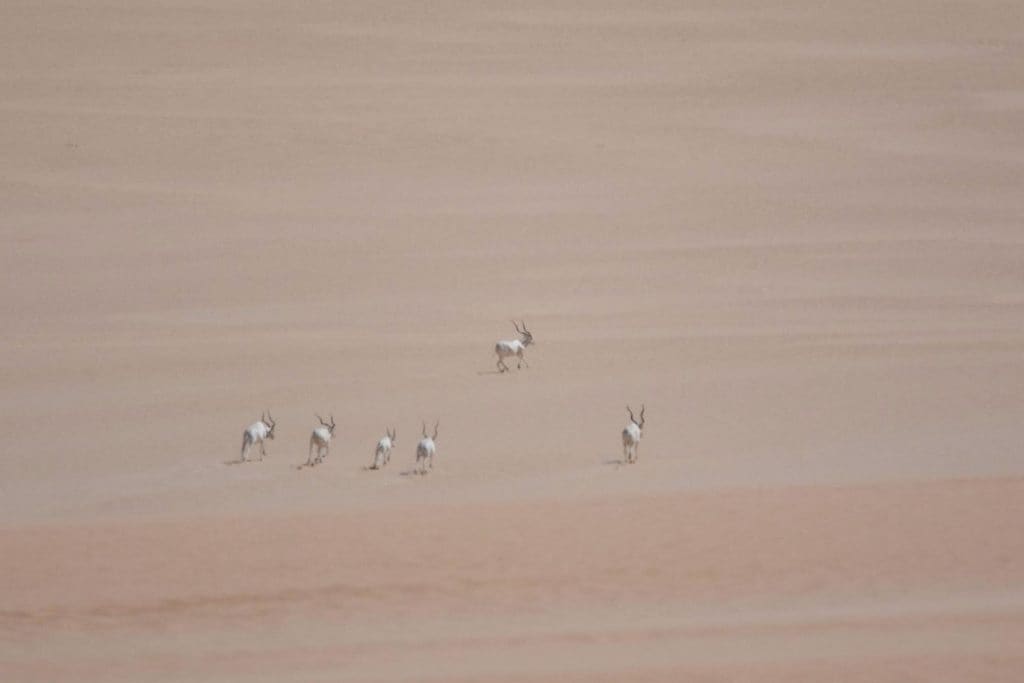Developing a regional action plan for addax and dama gazelle
Addax and dama gazelle were formerly distributed widely across the Sahara and Sahel. A catastrophic decline has taken place, especially during the last 40 years, that has brought both species close to extinction in the wild. Wild populations of addax and dama gazelle are now limited to a tiny number of small fragments of their historical range in Niger and Chad.

Addax and dama gazelle are listed on Appendix I of CITES and CMS. Both species are listed as Critically Endangered (the highest category of threat) on the IUCN Red List of Threatened Species.
International meetings
A workshop was held at the Royal Zoological Society of Scotland in November 2013 to review and discuss key issues for dama gazelle conservation. This resulted in an updated status review and a conservation road map with draft recommendations and proposed priority actions (RZSS & IUCN Antelope Specialist Group 2014). Another workshop took place at the Zoological Society of London in July 2016 to examine options for the restoration of addax in Chad and Niger.

Regional actions
A workshop took place in N’Djaména, Chad, on 24-25 April 2017 to develop a 2017-2022 regional action plan for the remaining wild populations of addax and dama gazelle in Niger and Chad. More precisely, the goal is to protect key populations of Addax in Chad and Niger using coordinated trans-boundary actions to improve knowledge and protection and where appropriate use reinforcement and reintroduction to increase population size and connectivity in natural range.The workshop was held under the auspices of IUCN/SSC Antelope Specialist Group and the Convention on Migratory Species (CMS) and the two national agencies DFCAP (Niger) and DCFAP (Chad) and was organized and funded by Noé.
Three very large protected areas are playing a key role in protection of the remaining populations of both species:
- Aïr & Ténéré National Nature Reserve in Niger,
- Termit & Tin Toumma National Nature Reserve in Niger,
- Ouadi Rimé-Ouadi Achim Game Reserve in Chad.
The government agencies (DFCAP in Niger and DCFAP in Chad) are fully engaged in the conservation of both species.
In the field
Several projects and international organizations have been engaged in survey, monitoring and community sensitization. These include: the SCF Pan-Sahara Wildlife Survey; Projet Antilopes Sahélo-Sahariennes, operated by CMS and implemented by Sahara Conservation Fund in close collaboration with the Zoological Society of London, and Projet d’appui à la gestion durable d’aires protégées sahélo-sahariennes, Niger et Tchad (Project of support for sustainable management of protected areas in Niger and Chad) implemented by Noé, in partnership with DCFAP, DFCAP and SC.

On the research side, the Royal Zoological Society of Scotland is leading an ongoing research project into the genetics of addax and dama gazelle (wild and captive populations), in collaboration with organizations working in the field, zoo associations like Al Ain Zoo and others.
A strategic action plan
The strategic action plan highlights three main priorities to save these two species:
- The first priority is to prevent the loss of more animals from the wild by ensuring effective protection from poaching at key sites and also extending protection to habitat, notably by establishing undisturbed zones away from water wells and livestock.
- The second one is to keep strong and effective links with the populations on site. Working with local communities who share the habitat and use the same pastures is essential to long-term success of conservation programs. Several agreements in TTTNNR have been signed by the traditional local and administrative authorities, including the Déclaration de Dolé (2007) and Déclaration de Dougoulé (2010).
- The Doungoumi Declaration was signed in December 2016 by leaders of the 65 communities in and around TTTNNR and contains a commitment to protect wildlife and includes collaboration on removal of unauthorized wells: this agreement could serve as a model for elsewhere in the region.
- It is impossible to plan effectively without accurate knowledge of the status of the two species. Establishing the fate of the largest addax population in Termit & Tin Toumma – whether it has been dispersed or greatly reduced, and locating remaining animals – is an urgent priority, as is establishing the extent and frequency of movement between sites. Monitoring programmes for all populations of addax and dama gazelle should be continued and expanded where feasible, using standardised protocols. It is also important to expand the current genetic research on the wild and captive populations of both species.
Next steps
SC and its partners will work together to raise funds and implement the priority actions defined by the action plan, including the possibility to reintroduce and reinforce the wild population of dama gazelle and addax in the near future.


